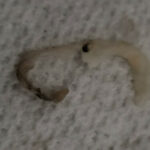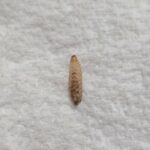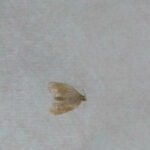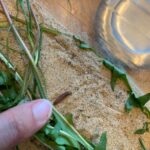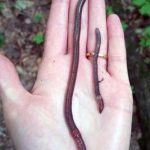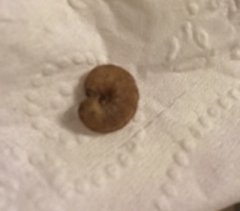The Luna Moth is a pale green but brilliantly colored moth that can only be seen flying around at night during the early weeks of summer and in the spring. A member of the Saturniidae family, the Luna Moth has a four and a half inch wingspan, making it one of the largest moths in North America. Luna moths even even have elongated tails, as well as pink legs, a white body, and two dots called “eyespots” on the hindwings. Males and females are slightly different. One of the easiest ways to distinguish between the two is to look at the antennae. Males have larger shaggier antennae.
The female Luna Moth lays around 200 eggs at once, on Black Walnut leaves. Within 10 days, the eggs hatch. The Luna Moth larvae emerge from the eggs and make their way to their favorite food sources. They immediately begin to feast on trees and shrubs such as American Beech, Black Cherry, Smooth Sumac, Red Maple, White Oak, American Chestnut, Sweetgum, hickories, and willows.
During the three to four weeks after hatching, the Luna Moth larvae will consume large quantities of trees and shrubs as their skins molt. Once the larvae reach its largest size (2 ½ inches in length), the larvae will enter its third stage of life called “pupa.” This resting stages prepares the larvae for the transition from pupa to adult. During this time, the pupa does not eat or move around. The pupa or “cocoon” is made of silk. The silk cocoon is usually hidden inside of a leaf where it will remain for two to three weeks. The exception to this time period is the season. If winter is near, the pupa will hatch in the spring.
When it is time for the pupa to leave its silk cocoon, it will make its way to the nearest tree trunk where it will hang its wings. The moth cannot fly at this point. It is weak and its wings are not yet strong enough to fly. Once hanging, the wings will fill with blood, causing them to “inflate.” This process typically takes place in the morning. By night, the adult moth is ready to find a mate. At this point, the moth no longer eats. Its only purpose is to mate and it must do so quickly. The Luna Moth only lives for a week.
Luna moths are considered an endangered species in some areas, so it is illegal to hunt them for their silks in some places. The Luna Moth has more to worry about than just hunters. In addition to loss of habitat and pollution at the hands of humans, the Luna Moth and its larvae have a number of natural predators that will attempt to pluck them from their hiding places. Luna Moth predators include the Barred owl, the Bald-faced Hornet, the Big Brown Bat, the Great Horned owl, and the Fiery Searcher.
Please click here for images of the beautiful Luna Moth and Luna Moth larvae or simply follow the links below:
http://plasticseraphim.com/pix/lunamoth.jpg
http://entnemdept.ufl.edu/creatures/misc/moths/luna_moth08.jpg
http://www.sierrapotomac.org/W_Needham/Pictures/LunaMoth_MillMtnTr_040626.jpg
http://www.fcps.edu/islandcreekes/ecology/Insects/Luna%20Moth/lunamoth3m1.jpg
All About Worms is always free, always reader-supported. Your tips via CashApp, Venmo, or Paypal are appreciated! Receipts will come from ISIPP Publishing.




